A Multi-Variable DTR Algorithm for the Estimation of Conductor Temperature and Ampacity on HV Overhead Lines by IoT Data Sensors
Abstract
:1. Introduction
2. Materials and Methods
- Weather unit: measurements of wind speed and direction, irradiation, ambient temperature, and relative humidity of the air;
- Mechanical sensors: tension monitoring on the 3 phases, measurement of acceleration/vibration, and inclination of the trellis.
- A thermal model, from which we derive an ex ante estimate;
- A mechanical model, from which we derive an ex post estimate.
2.1. Thermal Balance Equation
- Pj = heat generated inside the conductor due to the Joule effect (W/m);
- Ps = density of heat transmitted to the conductor by solar radiation (W/m);
- Pc = density of heat dissipated by convection (W/m);
- Pr = density of heat dissipated by radiation (W/m);
2.2. Mechanical Model
- temperature estimated with the mechanical model (t) (°C)
- : conductor temperature estimated with thermal model (t − 1) (°C)
- E = modulus of elasticity of the conductor (daN/mm2)
- α = thermal expansion coefficient of the conductor (1/°C)
- t: time of variable estimation
- Td: conductor tension (t) (kN)
- Tb: conductor tension (t − 1) (kN)
- a: span length (m)
- p: unitary transverse actions acting on the conductor (daN/m)
2.3. Bayesian Approach
3. Results
3.1. Evaluation of Conductor Temperature
3.2. Evaluation of Ampacity
3.3. Monte Carlo Validation
4. Conclusions
Author Contributions
Funding
Institutional Review Board Statement
Informed Consent Statement
Data Availability Statement
Acknowledgments
Conflicts of Interest
References
- Sulieman, N.A.; Ricciardi Celsi, L.; Li, W.; Zomaya, A.; Villari, M. Edge-Oriented Computing: A Survey on Research and Use Cases. Energies 2022, 15, 452. [Google Scholar] [CrossRef]
- Ricciardi Celsi, L.; Bonghi, R.; Monaco, S.; Normand-Cyrot, D. On the Exact Steering of Finite Sampled Nonlinear Dynamics with Input Delays. IFAC-Pap. 2015, 48, 674–679. [Google Scholar]
- Suraci, V.; Ricciardi Celsi, L.; Giuseppi, A.; Di Giorgio, A. A distributed wardrop control algorithm for load balancing in smart grids. In Proceedings of the 25th Mediterranean Conference on Control and Automation (MED), Garching bei München, Germany, 3–6 July 2017; pp. 761–767. [Google Scholar]
- Di Giorgio Giuseppi, A.; Liberati, F.; Ornatelli, A.; Rabezzano, A.; Ricciardi Celsi, L. On the optimization of energy storage system placement for protecting power transmission grids against dynamic load altering attacks. In Proceedings of the 25th Mediterranean Conference on Control and Automation (MED), Garching bei München, Germany, 3–6 July 2017; pp. 986–992. [Google Scholar]
- Arena, E.; Corsini, A.; Ferulano, R.; Iuvara, D.A.; Miele, E.S.; Ricciardi Celsi, L.; Sulieman, N.A.; Villari, M. Anomaly Detection in Photovoltaic Production Factories via Monte Carlo Pre-Processed Principal Component Analysis. Energies 2021, 14, 3951. [Google Scholar] [CrossRef]
- Soto, F.; Alvira, D.; Martin, L.; Latorre, J.; Lumbreras, J.; Wagensberg, M. Increasing the capacity of overhead lines in the 400 kV Spanish transmission network: Real time thermal ratings. Electra 1998, 22, 1–6. [Google Scholar]
- Seppa, T.O.; Salehian, A. Guide for Selection of Weather Parameters for Bare Overhead Conductor Ratings; CIGRE Technical Brochures; CIGRÉ: Paris, France, 2006; p. 299. [Google Scholar]
- Lawry, D.; Fitzgerald, B. Finding hidden capacity in transmission lines. N. Am. Wind. 2007, 4, 1–14. [Google Scholar]
- Black, C.R.; Chisholm, W.A. Key considerations for the selection of dynamic thermal line rating systems. IEEE Trans. Power Deliv. 2015, 30, 2154–2162. [Google Scholar] [CrossRef]
- Chisholm, W.A.; Barrett, J.S. Ampacity studies on 49 degrees C-rated transmission line. IEEE Trans. Power Deliv. 1989, 4, 1476–1485. [Google Scholar] [CrossRef]
- Halverson, P.G.; Syracuse, S.J.; Clark, R.; Tesche, F.M. Non-Contact Sensor System for Real-Time High-Accuracy Monitoring of Overhead Transmission Lines. EPRI Conf. Overhead Trans. Lines. 2008. Available online: https://www.halverscience.net/about_halverson/Promethean/files/EPRI_2008_paper_Promethean_Devices.pdf (accessed on 2 December 2021).
- Albizu, I.; Fernandez, E.; Eguia, P.; Torres, E.; Mazon, A.J. Tension and ampacity monitoring system for overhead lines. IEEE Trans. Power Deliv. 2013, 28, 3–10. [Google Scholar] [CrossRef] [Green Version]
- Seppa, T.O. Increasing transmission capacity by real time monitoring. In Proceedings of the 2002 IEEE Power Engineering Society Winter Meeting, New York, NY, USA, 27–31 January 2002. [Google Scholar]
- Engelhardt, J.S.; Basu, S.P. Design, installation, and field experience with an overhead transmission dynamic line rating system. In Proceedings of the IEEE Transmission and Distribution Conference, Los Angeles, CA, USA, 15–20 September 1996; pp. 366–370. [Google Scholar]
- Bernauer, C.; Böhme, H.; Hinrichsen, V.; Gromann, S.; Kornhuber, S.; Markalous, S.; Muhr, M.; Strehl, T.; Teminova, R. New method of temperature measurement of overhead transmission lines (OHTLs) utilizing surface acoustic wave (SAW) sensors. In Proceedings of the International Symposium on High Voltage Engineering, Ljubljana, Slovenia, 27–31 August 2007; pp. 287–288. [Google Scholar]
- Dawson, L.; Knight, A.M. Applicability of dynamic thermal line rating for long lines, Power Deli. IEEE Trans. 2018, 33, 719–727. [Google Scholar]
- Douglass, D.; Chisholm, W.; Davidson, G.; Grant, I.; Lindsey, K.; Lancaster, M.; Lawry, D.; McCarthy, T.; Nascimento, C.; Pasha, M.; et al. Real-time overhead transmission-line monitoring for dynamic rating. IEEE Trans. Power Deliv. 2016, 31, 921–927. [Google Scholar] [CrossRef]
- Sugihara, H.; Funaki, T.; Yamaguchi, N. Evaluation method for real-time dynamic line ratings based on line current variation model for representing forecast error of intermittent renewable generation. Energies 2017, 10, 503. [Google Scholar] [CrossRef] [Green Version]
- Esfahani, M.M.; Yousefi, G.R. Real time congestion management in power systems considering quasi-dynamic thermal rating and congestion clearing time. IEEE Trans. Industr. Inform. 2016, 12, 745–754. [Google Scholar] [CrossRef]
- Ippolito, M.G.; Massaro, F.; Zizzo, G.; Filippone, G.; Puccio, A. Methodologies for the exploitation of existing energy corridors. Gis Analysis and Dtr Applications. Energies 2018, 11, 979. [Google Scholar] [CrossRef] [Green Version]
- Ippolito, M.G.; Massaro, F.; Cassaro, C. HTLS conductors: A way to optimize RES generation and to improve the competitiveness of the electrical market—A case study in Sicily. J. Electr. Comput. Eng. 2018, 2018, 2073187. [Google Scholar] [CrossRef]
- IEEE Standard 738-2006; IEEE Standard for Calculating the Current-Temperature of Bare Overhead Conductors. The Institute of Electrical and Electronics Engineers, Inc.: New York, NY, USA, 2007.
- Thermal Behavior of Overhead Conductors; CIGRÉ Working Group 22.12; CIGRÉ: Paris, France, 2002; p. 207.
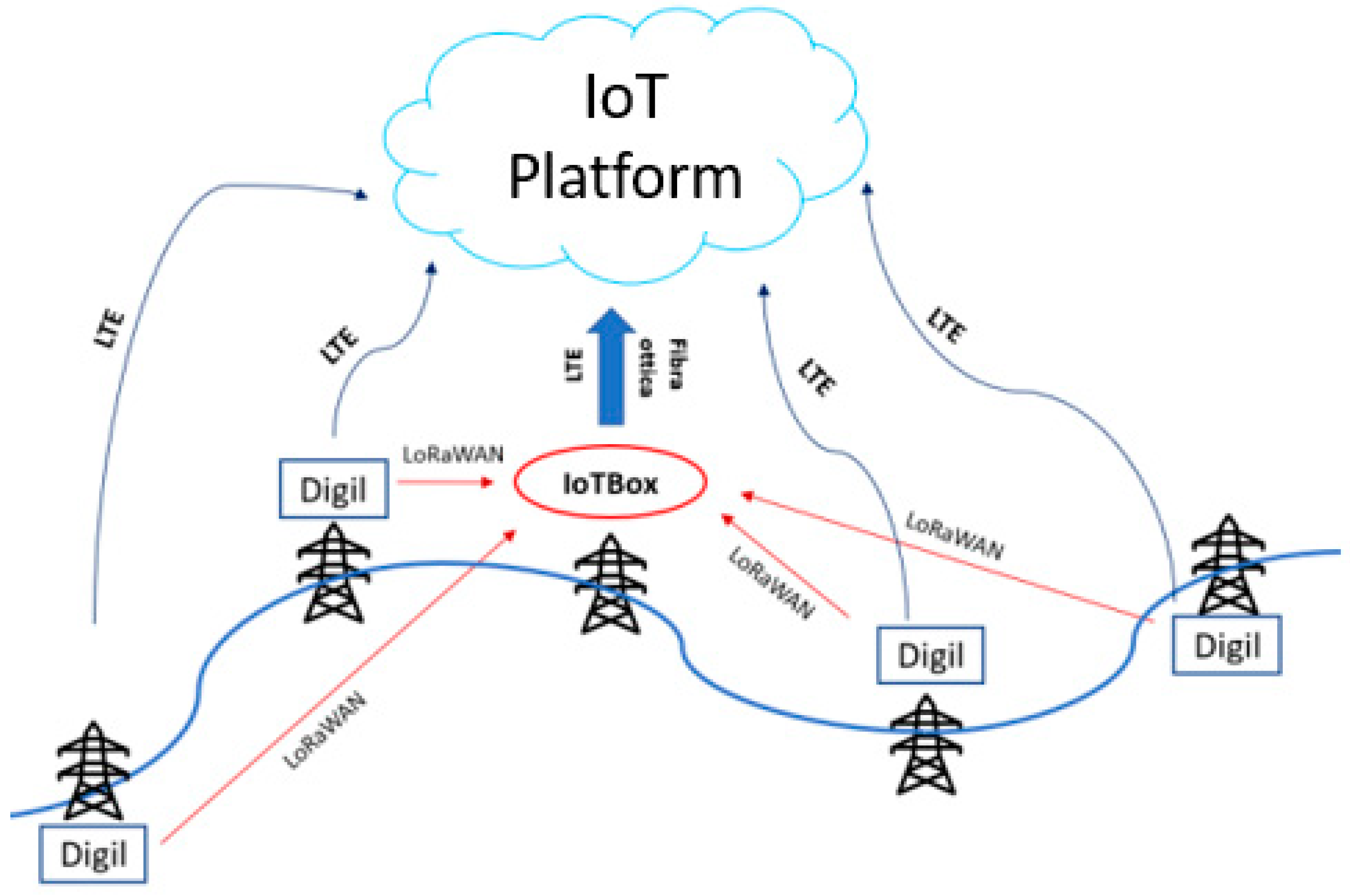

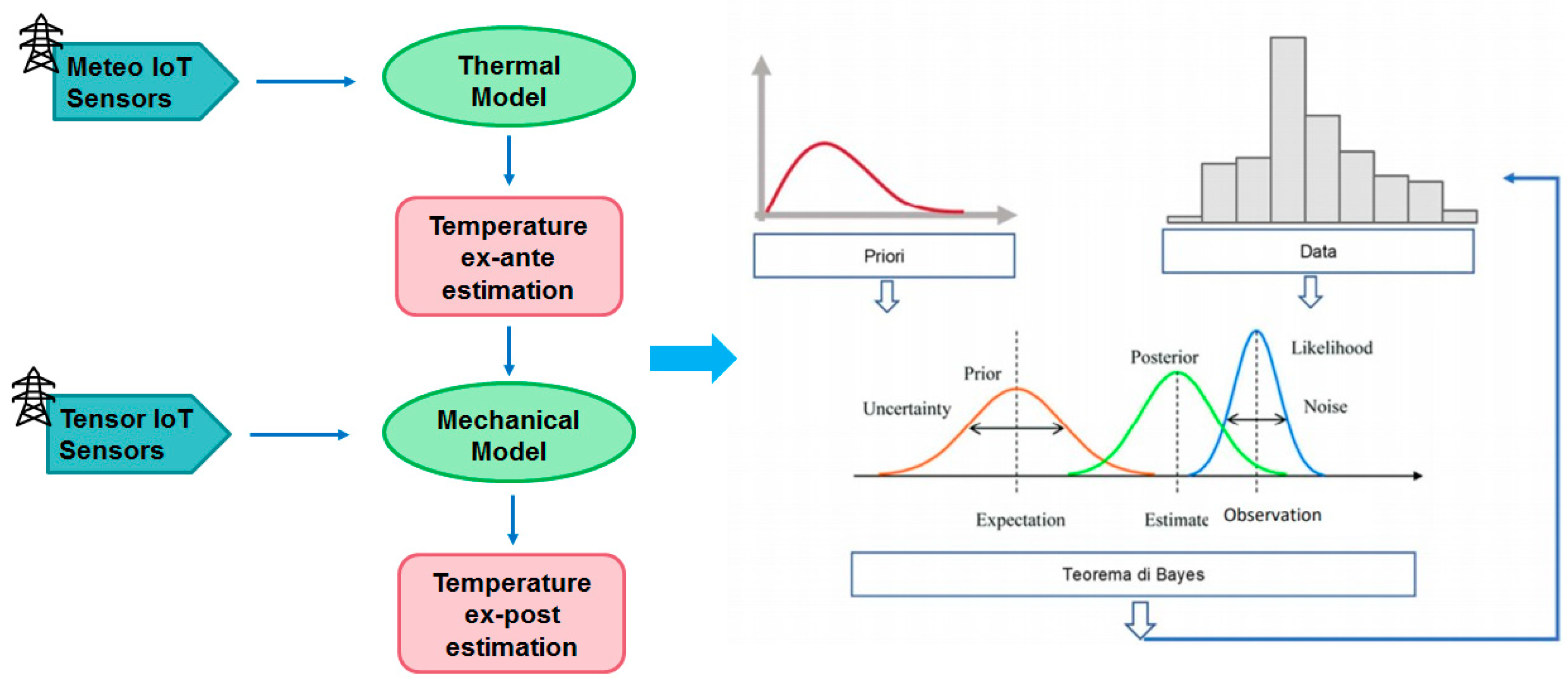

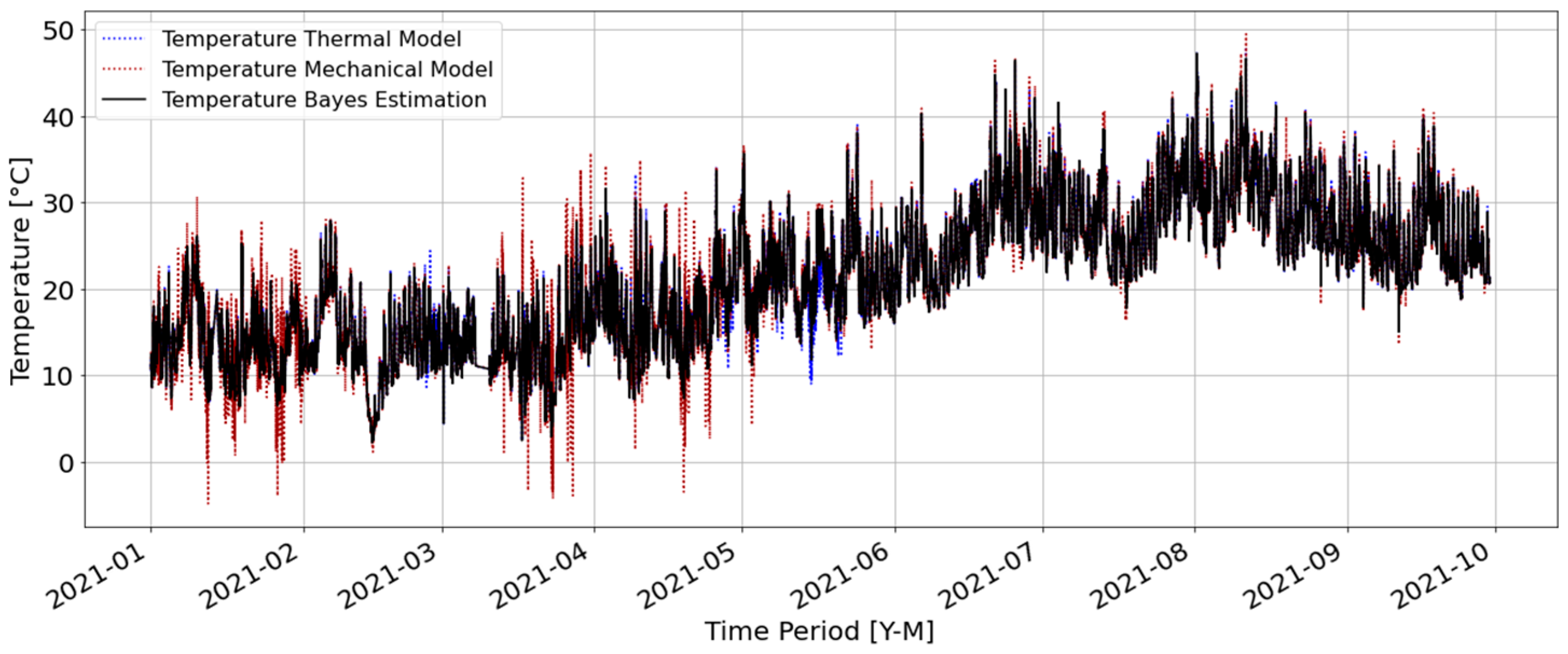
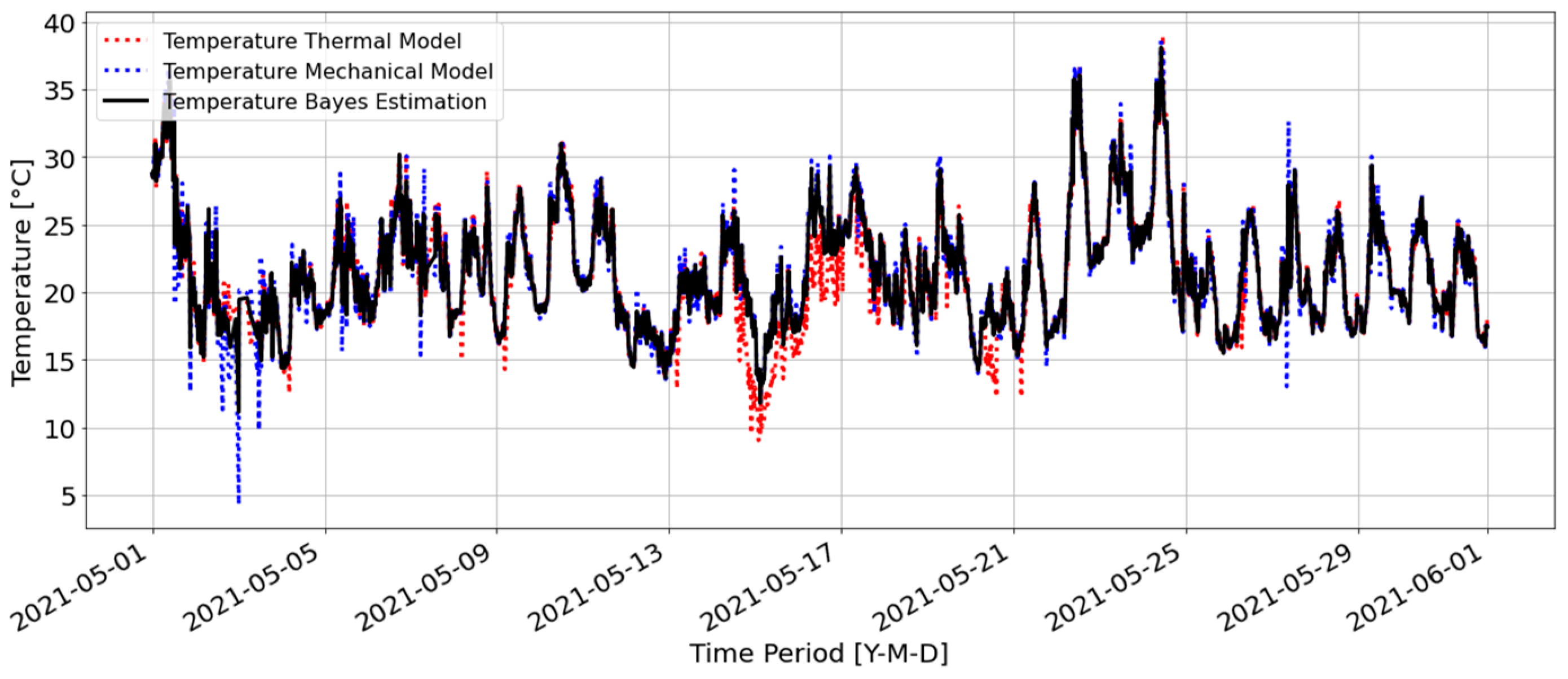

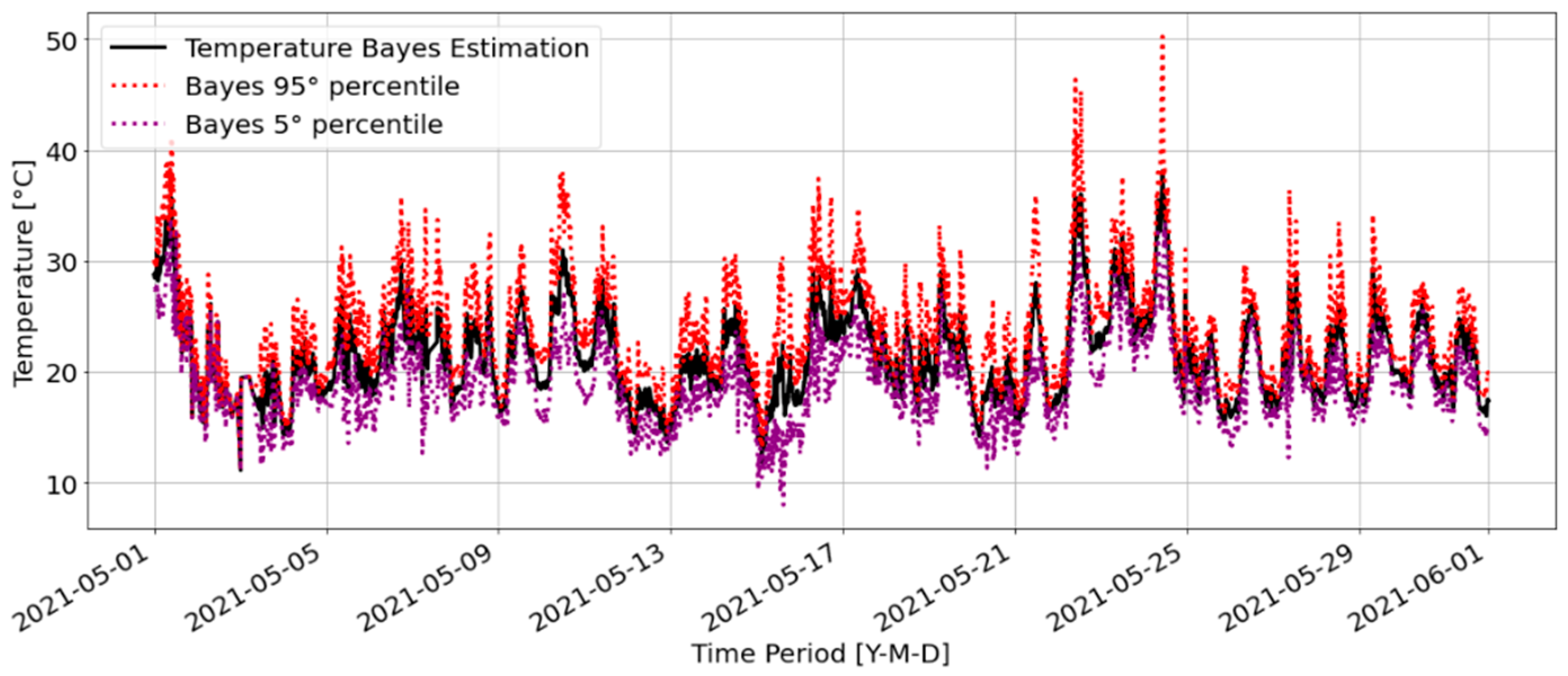
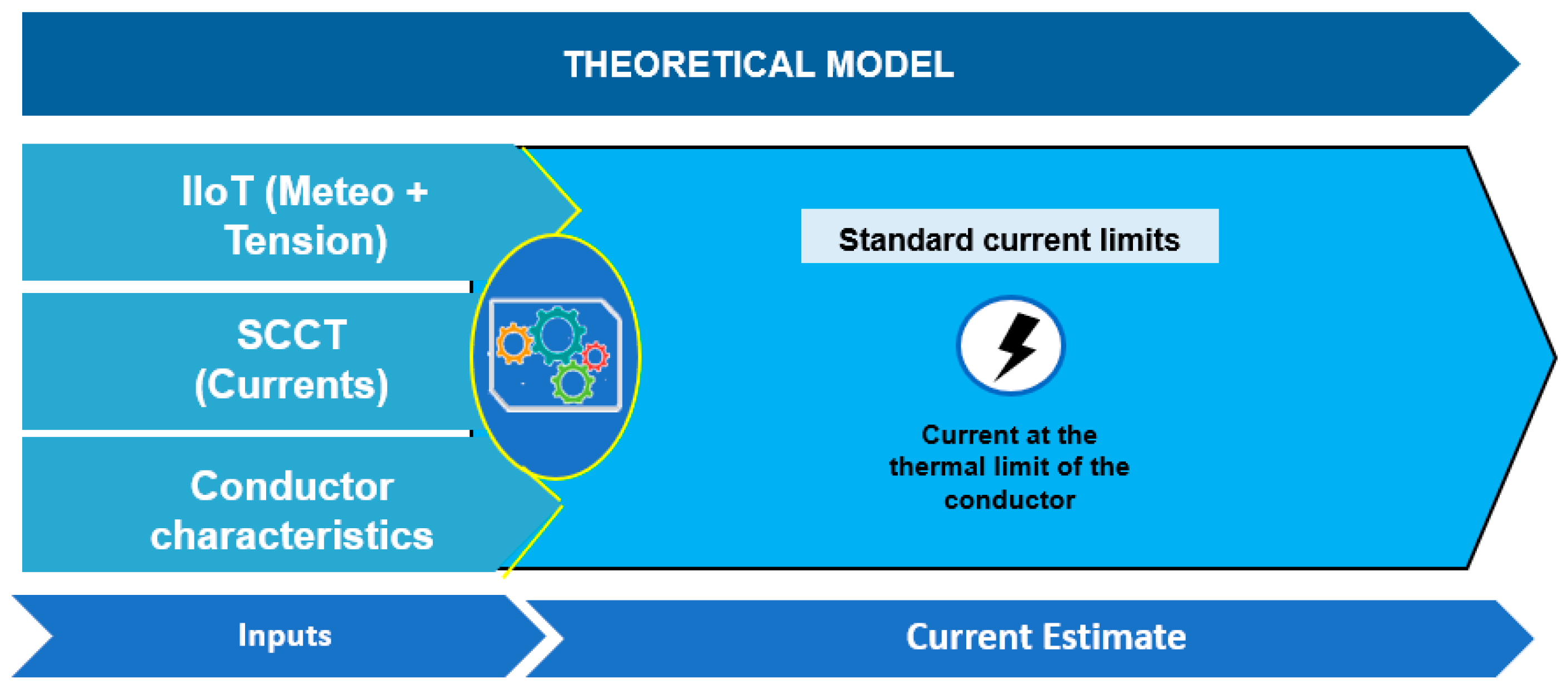

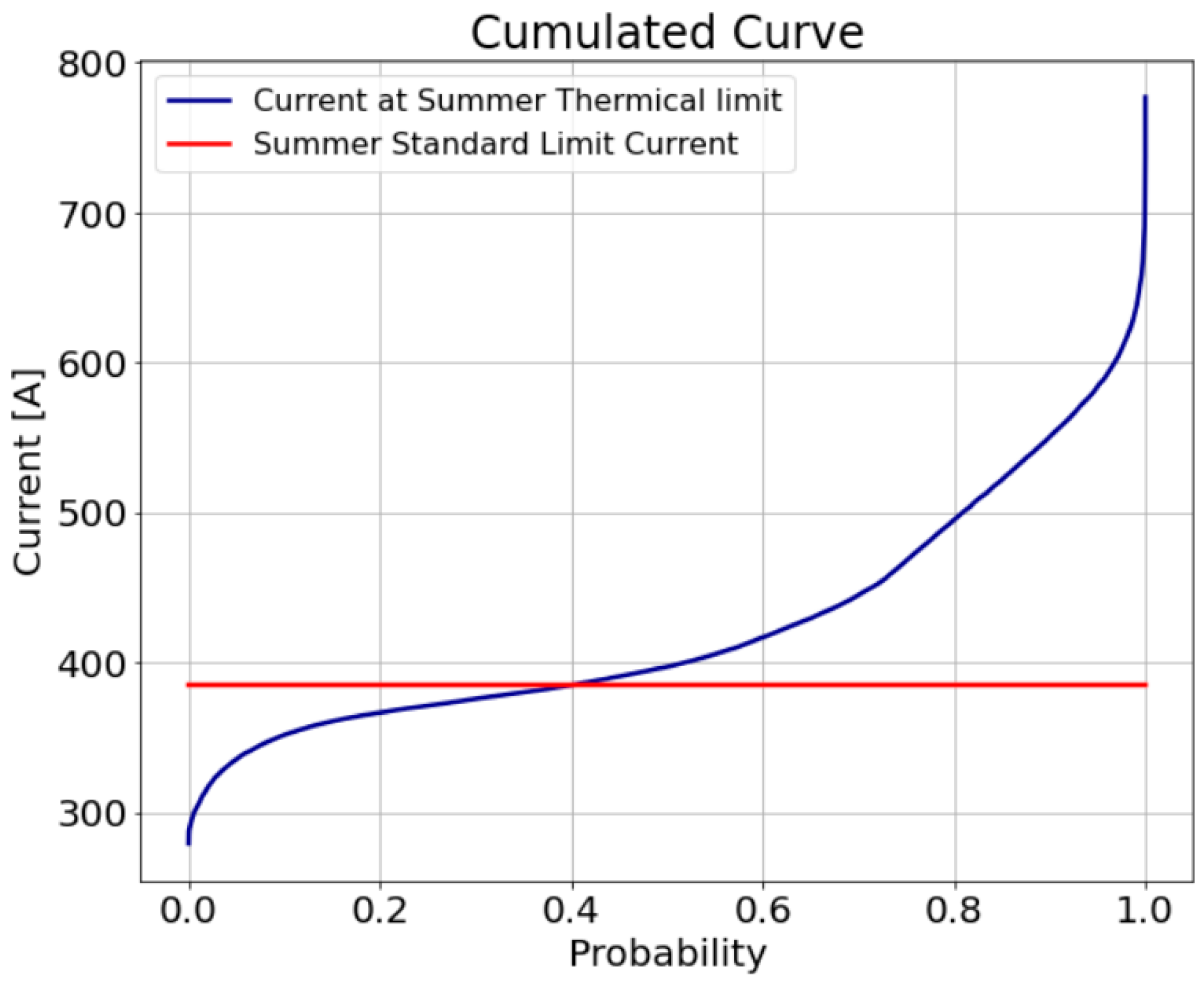
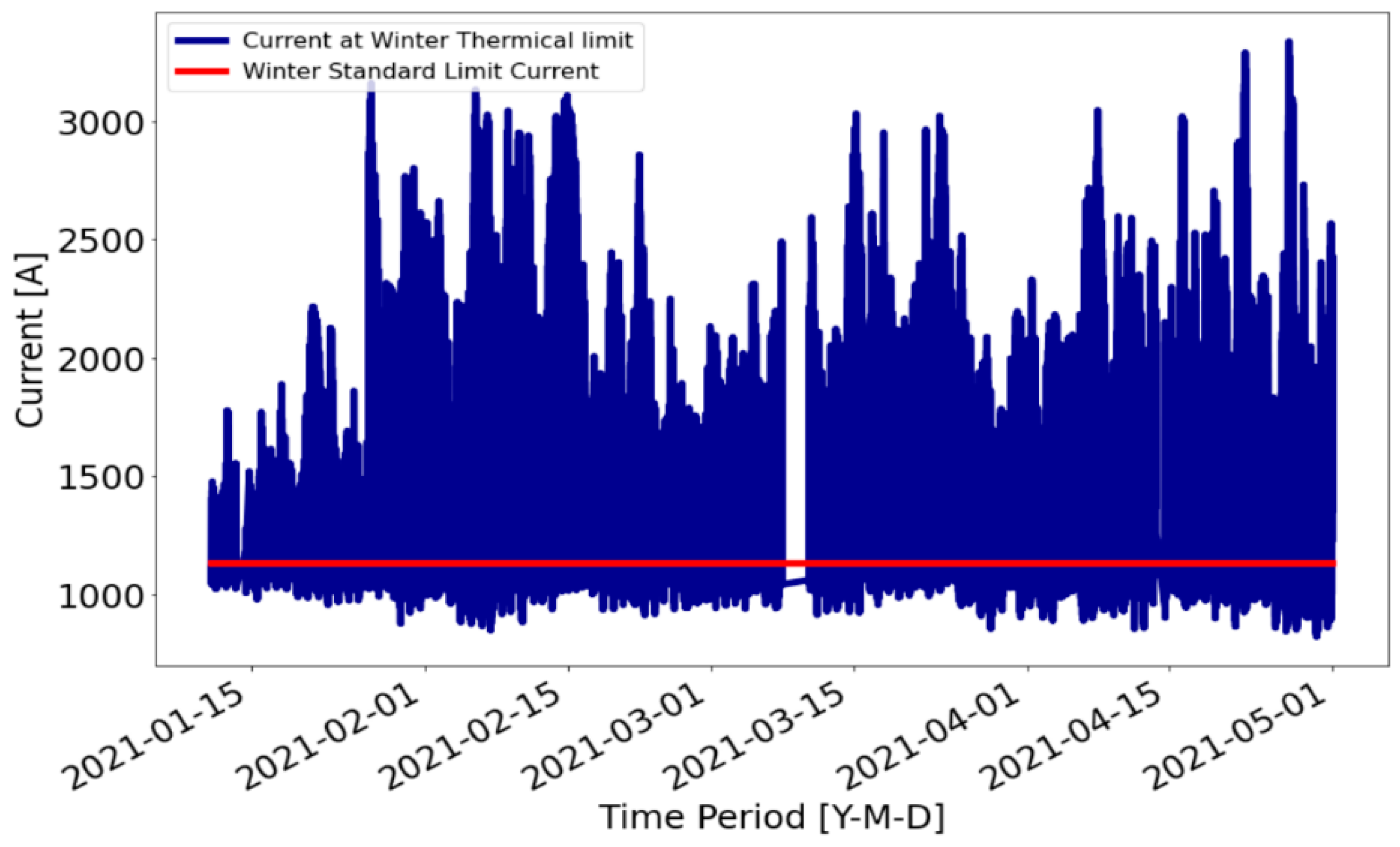
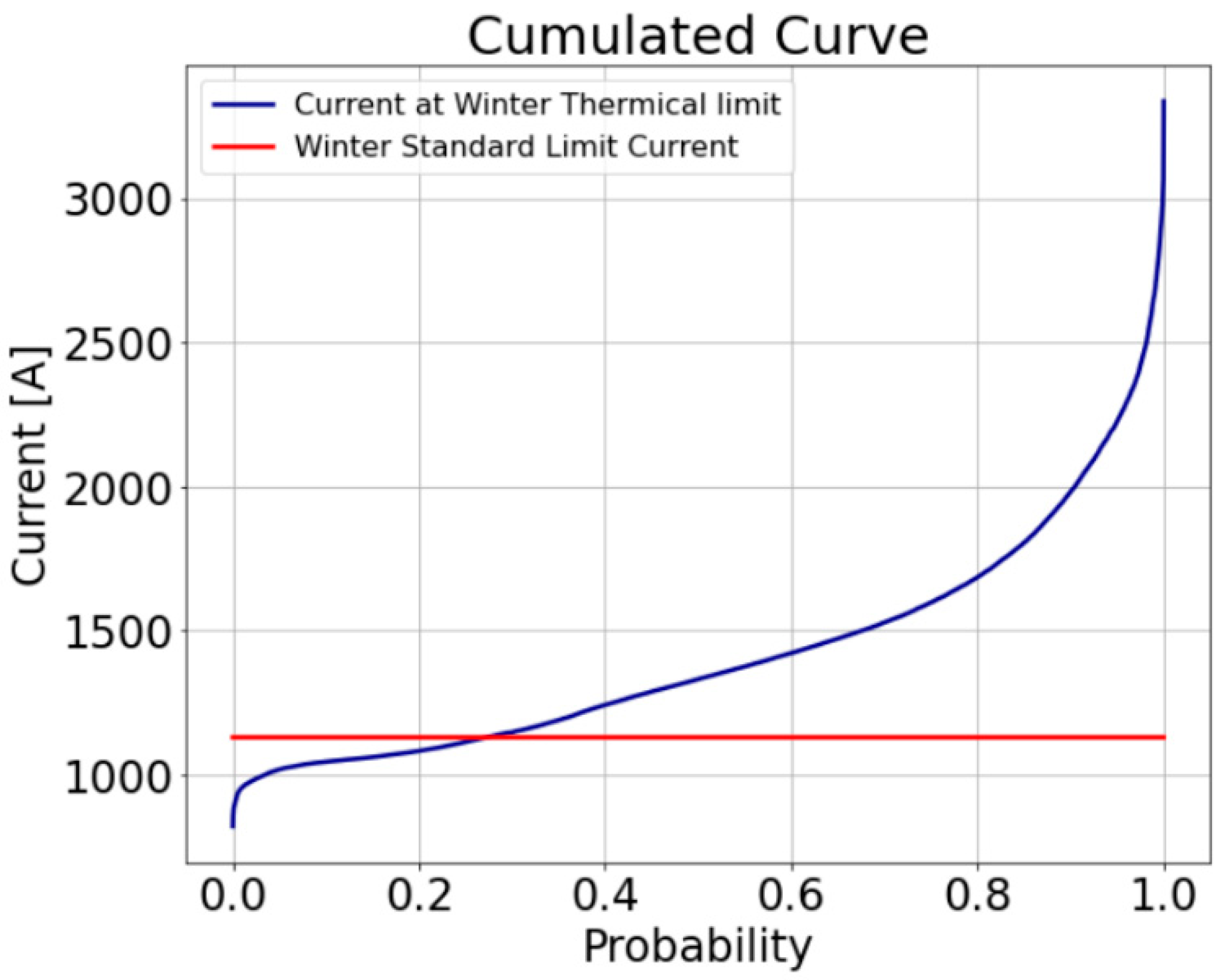
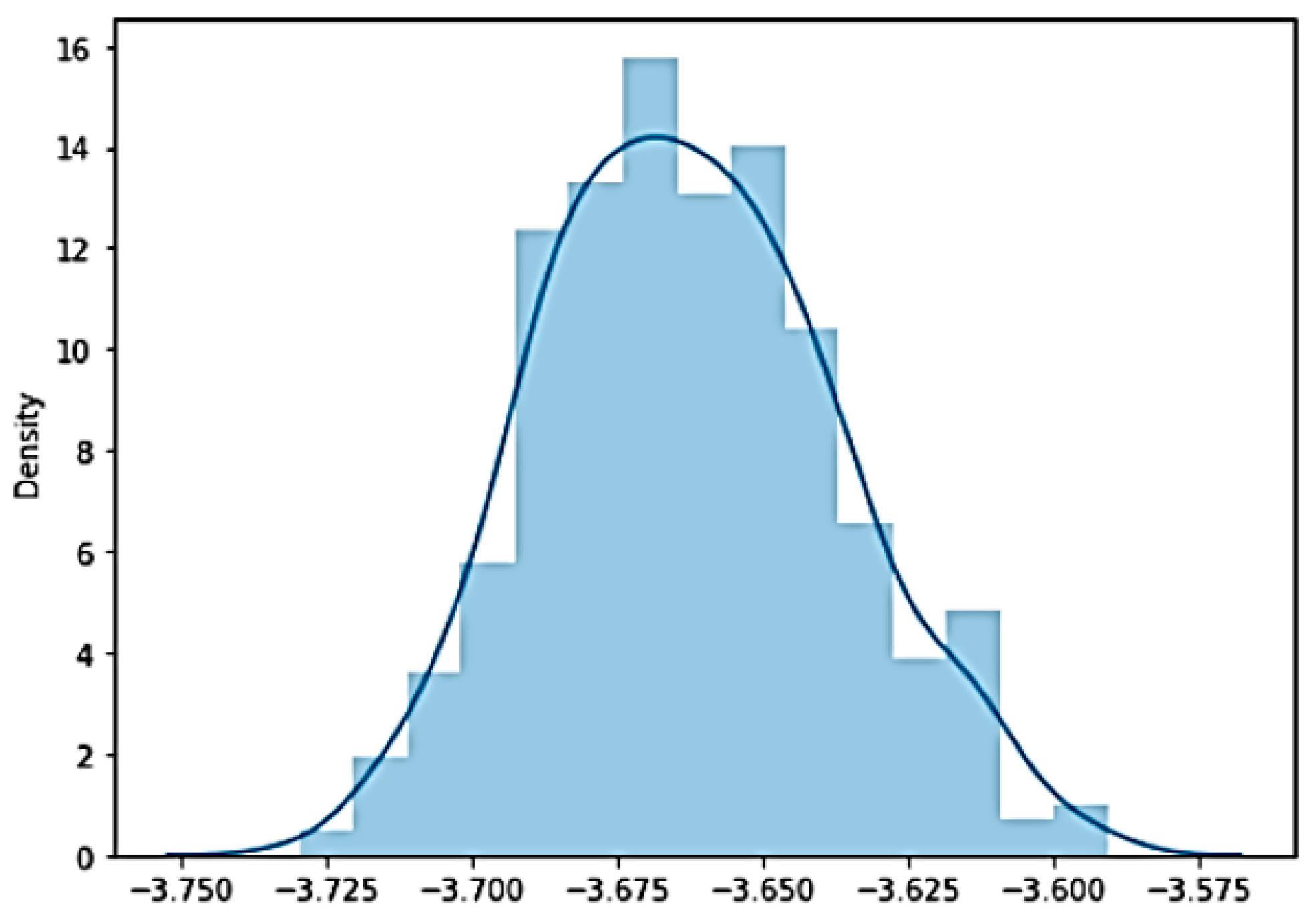
| Lines | Standard Value Thermal Model | Standard Value Mechanical Model | Mean Standard Deviation Bayes | Mean Diff Bayes 95 | Std Diff Bayes 95 | Cumulated Winter | Cumulated Summer | Mean Summer Limit | Mean Winter Limit |
|---|---|---|---|---|---|---|---|---|---|
| 1 | 1.980 | 2.527 | 1.342 | 4.911 | 2.783 | 28.429 | 8.266 | 369.274 | 463.147 |
| 2 | 1.010 | 1.137 | 0.615 | 2.250 | 2.504 | 40.205 | 3.694 | 172.560 | 103.157 |
| 3 | 1.230 | 2.827 | 0.921 | 3.370 | 2.462 | 34.174 | 6.993 | 288.907 | 398.028 |
| 4 | 1.298 | 1.445 | 0.872 | 3.191 | 2.660 | 50.753 | 20.459 | 71.782 | 79.996 |
| 5 | 0.795 | 0.870 | 0.516 | 1.887 | 2.318 | 47.527 | 24.429 | 54.273 | 88.309 |
| 6 | 1.463 | 1.736 | 1.015 | 3.717 | 3.042 | 64.274 | 40.096 | 83.131 | 89.161 |
| mean | 1.296 | 1.757 | 0.880 | 3.221 | 2.628 | 44.227 | 17.323 | 173.321 | 203.633 |
| Sensor | Accuracy |
|---|---|
| wind speed (km/h) | if <35: 0.02 * wind_speed, else: 0.03 * wind_speed |
| wind direction (°) | ±2 + wind_direction |
| air temperature (°C) | ±0.15 ± 0.1 * air_temperature |
| relative humidity (%) | ±(1.5 + 1.5 * humidity) |
| solar radiation (W/m2) | 10 ± 1 * solar_heating |
| ST401Sy datasheet160221 (kN) | ±1 * sensor_pull |
| ST413 datasheet160221 (kN) | ±1 * sensor_pull |
| ST461.1 datasheet160221 (kN) | ±1 * sensor_pull |
| ST461.2 datasheet160221 (kN) | ±1 * sensor_pull |
| Timestamp | Montecarlo | Model | Difference |
|---|---|---|---|
| 0 | −3.168 | −3.200 | 0.032 |
| 1 | −2.874 | −2.900 | 0.026 |
| 2 | −1.170 | −1.200 | 0.030 |
| 3 | −0.565 | −0.600 | 0.035 |
| 4 | −3.701 | −3.700 | 0.001 |
| 5 | −3.173 | −3.200 | 0.027 |
| 6 | −1.071 | −1.100 | 0.029 |
| 7 | −0.681 | −0.700 | 0.019 |
| 8 | −3.530 | −3.600 | 0.070 |
| 9 | −3.600 | −3.600 | 0.000 |
| 10 | −1.667 | −1.700 | 0.033 |
| 11 | −0.677 | −0.700 | 0.023 |
| 12 | −2.900 | −2.900 | 0.000 |
| 13 | −3.374 | −3.400 | 0.026 |
| 14 | −2.135 | −2.200 | 0.065 |
Publisher’s Note: MDPI stays neutral with regard to jurisdictional claims in published maps and institutional affiliations. |
© 2022 by the authors. Licensee MDPI, Basel, Switzerland. This article is an open access article distributed under the terms and conditions of the Creative Commons Attribution (CC BY) license (https://creativecommons.org/licenses/by/4.0/).
Share and Cite
Coccia, R.; Tonti, V.; Germanò, C.; Palone, F.; Papi, L.; Ricciardi Celsi, L. A Multi-Variable DTR Algorithm for the Estimation of Conductor Temperature and Ampacity on HV Overhead Lines by IoT Data Sensors. Energies 2022, 15, 2581. https://doi.org/10.3390/en15072581
Coccia R, Tonti V, Germanò C, Palone F, Papi L, Ricciardi Celsi L. A Multi-Variable DTR Algorithm for the Estimation of Conductor Temperature and Ampacity on HV Overhead Lines by IoT Data Sensors. Energies. 2022; 15(7):2581. https://doi.org/10.3390/en15072581
Chicago/Turabian StyleCoccia, Rossana, Veronica Tonti, Chiara Germanò, Francesco Palone, Lorenzo Papi, and Lorenzo Ricciardi Celsi. 2022. "A Multi-Variable DTR Algorithm for the Estimation of Conductor Temperature and Ampacity on HV Overhead Lines by IoT Data Sensors" Energies 15, no. 7: 2581. https://doi.org/10.3390/en15072581
APA StyleCoccia, R., Tonti, V., Germanò, C., Palone, F., Papi, L., & Ricciardi Celsi, L. (2022). A Multi-Variable DTR Algorithm for the Estimation of Conductor Temperature and Ampacity on HV Overhead Lines by IoT Data Sensors. Energies, 15(7), 2581. https://doi.org/10.3390/en15072581








